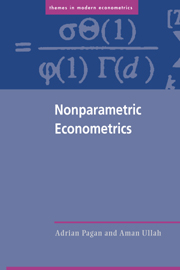Book contents
- Frontmatter
- Contents
- Preface
- 1 Introduction
- 2 Methods of Density Estimation
- 3 Conditional Moment Estimation
- 4 Nonparametric Estimation of Derivatives
- 5 Semiparametric Estimation of Single-Equation Models
- 6 Semiparametric and Nonparametric Estimation of Simultaneous Equation Models
- 7 Semiparametric Estimation of Discrete Choice Models
- 8 Semiparametric Estimation of Selectivity Models
- 9 Semiparametric Estimation of Censored Regression Models
- 10 Retrospect and Prospect
- A Statistical Methods
- References
- Index
2 - Methods of Density Estimation
Published online by Cambridge University Press: 03 December 2009
- Frontmatter
- Contents
- Preface
- 1 Introduction
- 2 Methods of Density Estimation
- 3 Conditional Moment Estimation
- 4 Nonparametric Estimation of Derivatives
- 5 Semiparametric Estimation of Single-Equation Models
- 6 Semiparametric and Nonparametric Estimation of Simultaneous Equation Models
- 7 Semiparametric Estimation of Discrete Choice Models
- 8 Semiparametric Estimation of Selectivity Models
- 9 Semiparametric Estimation of Censored Regression Models
- 10 Retrospect and Prospect
- A Statistical Methods
- References
- Index
Summary
Introduction
This chapter describes various methods of estimating the univariate density function of a random variable, closing with extensions to the multivariate case. Some motivation needs to be given for why we should be interested in density estimation at all. An important reason is that the techniques used in, and the complications arising from, the nonparametric estimation of densities recur many times in later chapters, and it pays to study them in a simplified setting first. But, apart from this pragmatic purpose, the need to estimate densities does arise in practice sufficiently often to make a study of this literature of interest in its own right.
Broadly, one can distinguish three areas in which the need to estimate densities arises. First, density estimates can be important in capturing the stylized facts that need explanation and for judging how well a potential model is likely to fit the data. For example, if it is known that the variable being examined has a density with fat tails, or strong peaks, any model of data corresponding to such a variable needs to be capable of generating a density with this characteristic. In other instances, one can efficiently learn about interrelationships between variables in large data sets from joint density estimates – a feature well illustrated in Deaton's (1989) work on rice subsidies in Thailand, in Marron and Schmitz's (1992) work on the U.K. income distribution, in Dinardo et al.'s (1996) study on the U.S. distribution of wages conditional on labor market institutions, and in Quah's (1997) cross-country analysis of the growth and convergence of economies.
- Type
- Chapter
- Information
- Nonparametric Econometrics , pp. 5 - 77Publisher: Cambridge University PressPrint publication year: 1999

